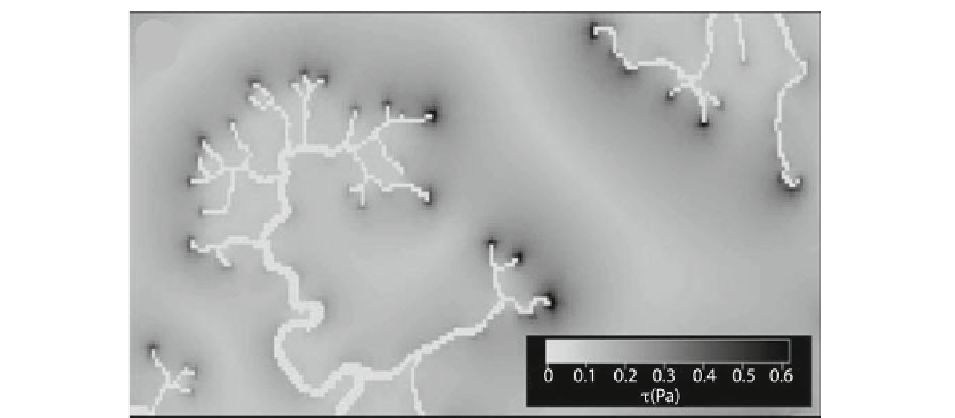Geology Reference
In-Depth Information
Fig. 11.6
Distribution of shear stress within a tidal channel - tidal fl at system (Adapted from D'Alpaos et al.
2005
)
where fl ow from the platform is focused into the creek
(D'Alpaos et al.
2005
). The shear stress is calculated
based on the gradient of the water surface across the
marsh surface using a Poisson model (Rinaldo et al.
1999
), which assumes that the microtopography on the
marsh surface and the water surface slope are both
much smaller than the absolute water depth, and that
friction is only applied to the marsh surface rather than
to the channel. The reported shear stresses near the
channel head are suffi cient to cause erosion (Fig.
11.6
).
This supports the idea of headward erosion and lateral
erosion as mechanisms for channel growth and elabo-
ration, respectively.
overbank fl ow creates convoluted transport pathways
and residence times. Conservation of mass or momen-
tum within an individual channel may not hold
due to overbank fl ows to adjacent channels, or
because of the loss of integrity of defi ned 'creek-
sheds' (i.e., in situations where the watershed is not
defi ned by a topographic high and is overtopped
during a spring tide, water on the marsh surface or
tidal fl at may fl ood and ebb through different creeks;
French and Stoddart
1992
) . Sediment transport is
also complicated by bioturbation and biostabili-
zation (either by biofi lm or vegetation). Vegetation
may also influence sediment transport though
baffl ing of fl ow or by inducing scour (Temmerman
et al.
2007
) .
Figure
11.7
depicts the typical behavior within a
tidal gully in the Wadden Sea. During the period when
the banks are overtopped, ebb velocities are low (the
opposite of fl uvial systems). As discussed above peak
velocities occur just after water depth in the channel
falls below bankfull. A peak in sediment transport is
associated with this velocity maximum, as fast fl ows
erode the channel and tidal fl ats. Net fl ux out of the
small channel may still not necessarily be indicative of
the behavior of other channels in the system. In many
tidal systems high suspended sediment loads are
advected around the system, either coming from nearby
rivers or from offshore.
11.4.5 Implication for Sediment Transport
A large number of researchers have investigated the
sediment fl ux within tidal channels (Settlemyre and
Gardner
1977
; French and Stoddart
1992
; Mudd
et al.
2010
). In general, sediment transport within
intertidal systems is highly complex; this is a direct
result of the equally complicated hydrodynamics.
Tidal range and asymmetry vary throughout sys-
tems; thus, as mentioned previously, the measure-
ment of flood dominance in one creek does not
mean the entire system is experiencing the same net
fl ux of sediment. Furthermore, the occurrence of

